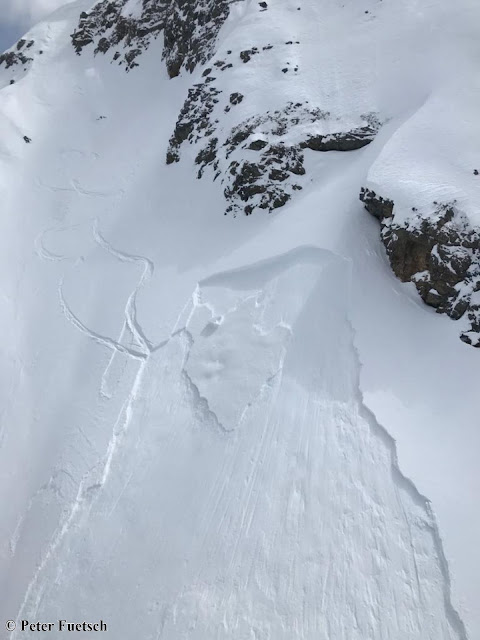At 1.00 pm on 17.04 Headquarters Tirol received an emergency call about an avalanche accident on Grosser Zunig south of Matrei in East Tirol. Two backcountry tourers were caught by a slab during their descent and swept over rocky terrain. One person died at the scene of the accident, the second person was flown to the Innsbruck Clinic with grave injuries.
 |
| The red ellipse marks the scene of the accident north of Grosser Zunig. At the upper edge is Matrei in Osttirol (c) tiris |
The slab triggered in extremely steep terrain on a north-facing slope at about 2550m altitude. The release was caused by a surface-layer snowdrift problem due to recent strong-wind impact. On-site inspection is not planned due to current weather developments and the highly exposed nature of the terrain.
 |
| Arrow marks the entry zone (photo: 17.04.2021) |
 |
| Two entry tracks into the slab. Fracture depth varies, estimated between 30 cm and 70 cm. (photo: 17.04.2021) |
 |
| Arrow marks the upper rim of the slab fracture. (photo: 17.04.2021) |
Additional information about the current situation
We have received new reports and observations about the formation of dp.4 (cold on warm). It occurs in sunny very steep terrain starting at about 2200m in particular. One exception was registered in the Stubai Alps: a south-facing slope at 2050m. Settling noises are a frequent indicator for this old-snow problem.
Snow quality is currently poor in sunny terrain. Breakable melt-freeze crusts dominate.
Over the last few days, many descents have been made on north-facing slopes, also in extremely steep terrain. This shows that avalanche prone locations are not highly prevalent on north-facing slopes.
Problem zones on north-facing slopes are most likely in North Tirol in a narrow altitude band around 2300m. In that zone a thin rain crust formed on 2 April, beneath that a thin layer of faceted crystals which formed during the phase of fine weather until the beginning of April,
- in spots of shallow snow at high altitudes where there are nests of depth hoar
- in the form of freshly generated snowdrift accumulations in extremely steep terrain